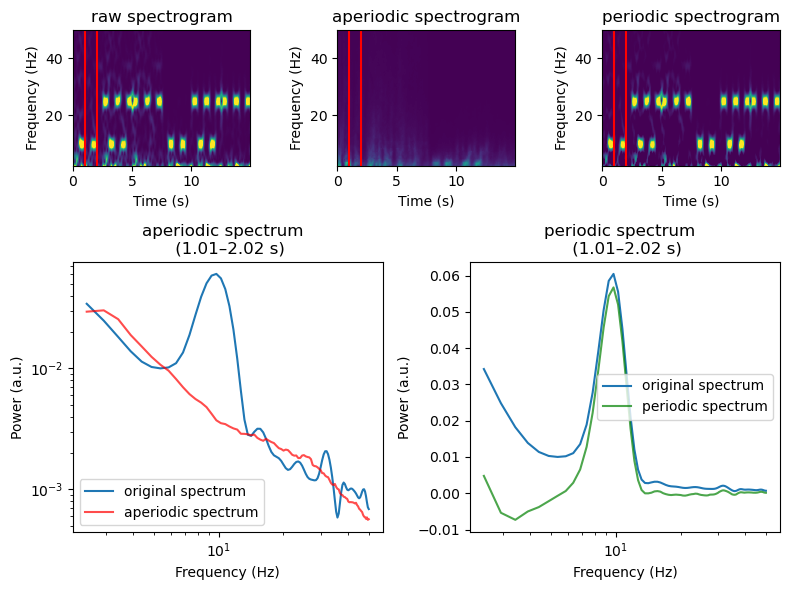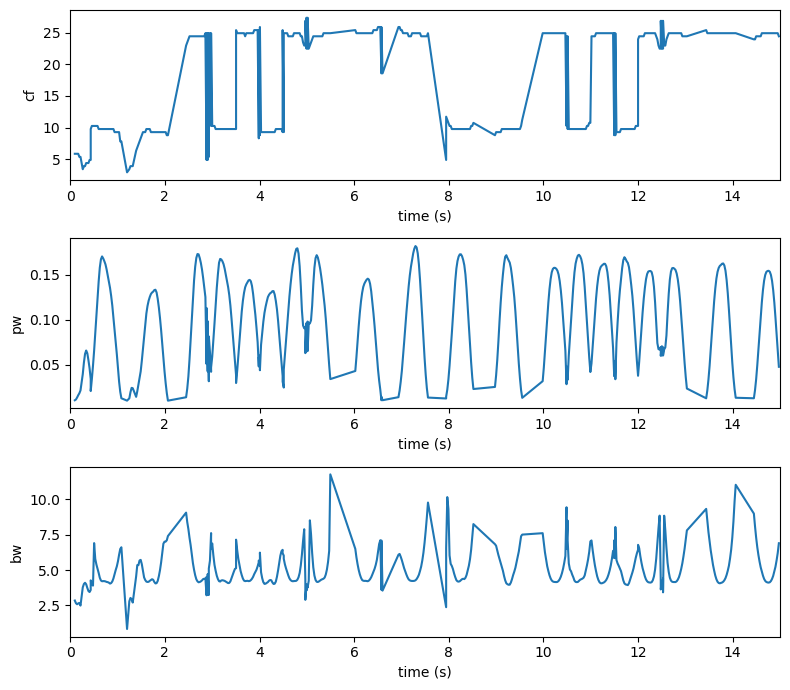Run IRASA timeresolved#
In the original IRASA manuscript Wen & Liu (2016) show that the algorithm can be used in the time-frequency domain. The authors used this in a subsequent manuscript to investigate changes periodic and aperiodic activity over time and even computed broadband correlations of aperiodic activity over channels across time (see Wen & Liu, 2016). To make this form of analysis more accessible and track aperiodic and periodic changes over time we implemented the irasa_sprint function, that similarly to the SPRiNT package (Wilson, da Silva Castanheira & Baillet, 2022), enables you to compute periodic and aperiodic spectrograms.
[1]:
import sys
from neurodsp.sim import set_random_seed
from neurodsp.sim import sim_powerlaw, sim_oscillation
from neurodsp.utils import create_times
from neurodsp.plts import plot_timefrequency#
import numpy as np
import matplotlib.pyplot as plt
import matplotlib as mpl
new_rc_params = {'text.usetex': False,
"svg.fonttype": 'none'
}
mpl.rcParams.update(new_rc_params)
set_random_seed(84)
from pyrasa.irasa import irasa_sprint
/Users/fabian.schmidt/git/pyrasa/.pixi/envs/default/lib/python3.12/site-packages/neurodsp/sim/cycles.py:350: SyntaxWarning: invalid escape sequence '\p'
cycle = ((cos(2\pi ft) + 1) / 2)^{exp}
/Users/fabian.schmidt/git/pyrasa/.pixi/envs/default/lib/python3.12/site-packages/neurodsp/sim/cycles.py:400: SyntaxWarning: invalid escape sequence '\s'
cycle = \sum_{j=1}^{j} \dfrac{1}{j^2} \cdot cos(j2\pi ft)+(j-1)*\phi
Lets firs generate a signal with some alpha and beta bursts alongside a change in the spectral exponent
[2]:
# Set some general settings, to be used across all simulations
fs = 500
n_seconds = 15
duration=4
overlap=0.5
# Create a times vector for the simulations
times = create_times(n_seconds, fs)
alpha = sim_oscillation(n_seconds=.5, fs=fs, freq=10)
no_alpha = np.zeros(len(alpha))
beta = sim_oscillation(n_seconds=.5, fs=fs, freq=25)
no_beta = np.zeros(len(beta))
exp_1 = sim_powerlaw(n_seconds=2.5, fs=fs, exponent=-1)
exp_2 = sim_powerlaw(n_seconds=2.5, fs=fs, exponent=-2)
alphas = np.concatenate([no_alpha, alpha, no_alpha, alpha, no_alpha])
betas = np.concatenate([beta, no_beta, beta, no_beta, beta])
sim_ts = np.concatenate([exp_1 + alphas,
exp_1 + alphas + betas,
exp_1 + betas,
exp_2 + alphas,
exp_2 + alphas + betas,
exp_2 + betas, ])
Now we compute a time frequency spectrum using morlet wavelets and additionally decompose the data in the time frequency domain using pyrasa’s irasa_sprint function
[3]:
freqs = np.arange(1, 50, 0.5)
import scipy.signal as dsp
irasa_sprint_spectrum = irasa_sprint(sim_ts, fs=fs,
band=(1, 50),
overlap_fraction=.95,
win_duration=.5,
hset_info=(1.05, 4., 0.05),
win_func=dsp.windows.hann)
Lets check whats stored in the IrasaTfSpectrum returned by irasa_sprint
[4]:
print(irasa_sprint_spectrum)
IrasaTfSpectrum Summary
------------------------
Channels : 1 unnamed channel
Frequency (Hz): 2.44–49.80 Hz, Δf ≈ 0.49 Hz
Time (s) : 0.00–14.98 s, Δt ≈ 0.02 s
Attributes : raw_spectrum, aperiodic, periodic, freqs, ch_names, time
Methods : fit_aperiodic_model(), get_peaks(), get_aperiodic_error()
When we now plot the data we can see that we have nicely seperated our prediodic and aperiodic spectra in time
[5]:
#%%
f, axes = plt.subplots(figsize=(14, 4), ncols=3)
plot_timefrequency(irasa_sprint_spectrum.time, irasa_sprint_spectrum.freqs, np.squeeze(irasa_sprint_spectrum.raw_spectrum), vmin=0, vmax=0.1, ax=axes[0])
plot_timefrequency(irasa_sprint_spectrum.time, irasa_sprint_spectrum.freqs, np.squeeze(irasa_sprint_spectrum.aperiodic), vmin=0, vmax=0.1, ax=axes[1])
plot_timefrequency(irasa_sprint_spectrum.time, irasa_sprint_spectrum.freqs, np.squeeze(irasa_sprint_spectrum.periodic), vmin=0, vmax=0.1, ax=axes[2])
for ax, title in zip(axes, ['Original Spectrogram', 'Aperiodic Spectrogram', 'Periodic Spectrogram',]):
ax.set_title(title)

[6]:
irasa_sprint_spectrum.plot(time_range = (1., 2), vmin=0., vmax=0.1)

Now we can specify an aperiodic model and fit it to our aperiodic spectrogram
[7]:
ap_spec = irasa_sprint_spectrum.fit_aperiodic_model()
We can visualize the aperiodic changes alongside the goodness of fit, to see whether its matching our expectations
[11]:
f, ax = plt.subplots(nrows=3, figsize=(8, 7))
ax[0].plot(ap_spec.aperiodic_params['time'], ap_spec.aperiodic_params['Offset'])
ax[0].set_ylabel('Offset')
ax[0].set_xlabel('time (s)')
ax[1].plot(ap_spec.aperiodic_params['time'], ap_spec.aperiodic_params['Exponent'])
ax[1].set_ylabel('Exponent')
ax[1].set_xlabel('time (s)')
ax[2].plot(ap_spec.aperiodic_params['time'], ap_spec.gof['R2'])
ax[2].set_ylabel('R2')
ax[2].set_xlabel('time (s)')
f.tight_layout()

Similarly we can extract our peaks or putatively oscillatory activity in time, by using the get_peaks method
[8]:
peaks_spec = irasa_sprint_spectrum.get_peaks(cut_spectrum=(1, 40),
smooth=True,
smoothing_window=1,
peak_threshold=2,
min_peak_height=0.01,
peak_width_limits=(0.5, 12))
[9]:
f, ax = plt.subplots(nrows=3, figsize=(8, 7))
for ix, cur_key in enumerate(['cf', 'pw', 'bw']):
ax[ix].plot(peaks_spec['time'], peaks_spec[cur_key])
ax[ix].set_ylabel(cur_key)
ax[ix].set_xlabel('time (s)')
ax[ix].set_xlim(0, 15)
f.tight_layout()

We can further check whether the number of extracted peaks matches our expectations. Looks pretty good to me :)
[10]:
from pyrasa.utils.peak_utils import get_band_info
df_alpha = get_band_info(peaks_spec, freq_range=(8,12), ch_names=[])
alpha_peaks = df_alpha.query('pw > 0.10')
beta_ts = alpha_peaks['time'].to_numpy()
t1 = beta_ts[0]
n_peaks = 0
for ix, i in enumerate(beta_ts):
try:
diff = beta_ts[ix + 1] - i
if diff > 0.025:
n_peaks += 1
except IndexError:
pass
n_peaks
#%%
df_beta = get_band_info(peaks_spec, freq_range=(20, 30), ch_names=[])
beta_peaks = df_beta.query('pw > 0.10')
beta_ts = beta_peaks['time'].to_numpy()
t1 = beta_ts[0]
n_peaks = 0
for ix, i in enumerate(beta_ts):
try:
diff = beta_ts[ix + 1] - i
if diff > 0.025:
n_peaks += 1
except IndexError:
pass
n_peaks
# %%
f, ax = plt.subplots(figsize=(12, 4), ncols=2)
ax[0].plot(df_alpha['time'], df_alpha['pw'])
ax[1].plot(df_beta['time'], df_beta['pw'])
yax = ['Alpha Power (8-12Hz)', 'Beta Power (20-30Hz)']
for ix, c_ax in enumerate(ax):
c_ax.axhline(0.1, color='r', linestyle='--')
c_ax.set_xlabel('Time (s)')
c_ax.set_ylabel(yax[ix])
f.tight_layout()

[ ]:
[ ]:
[ ]: